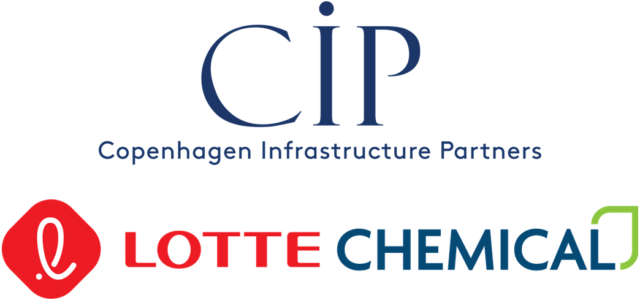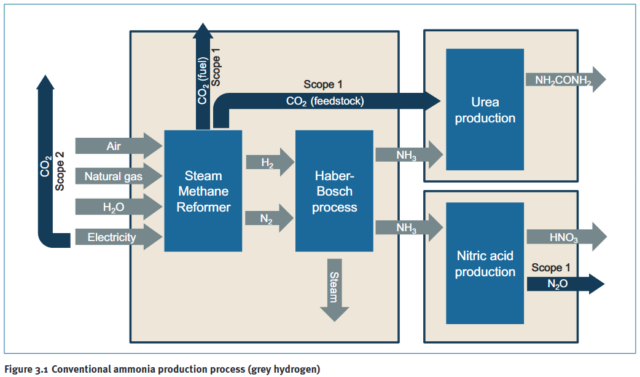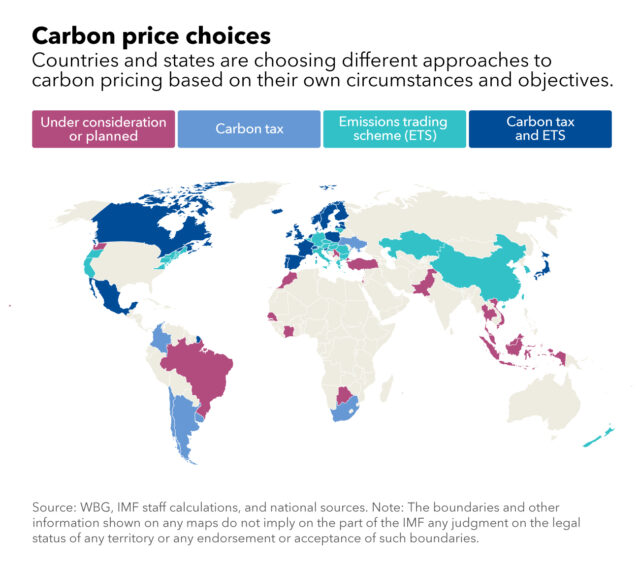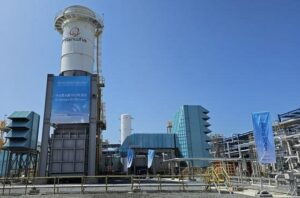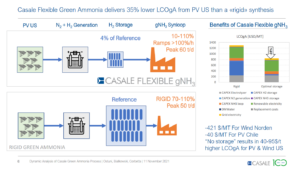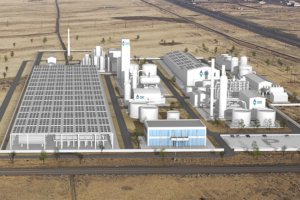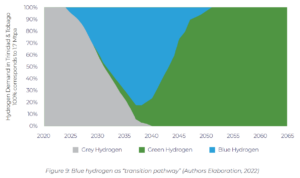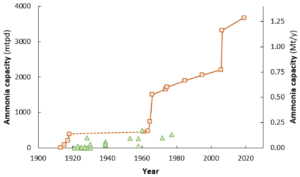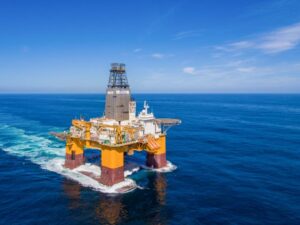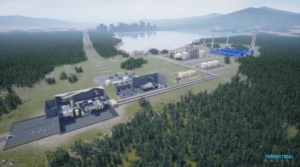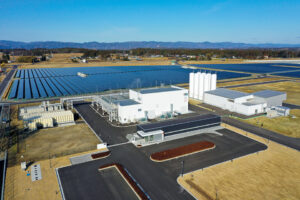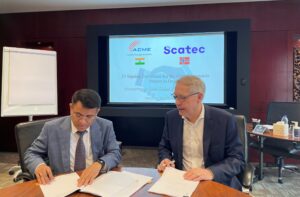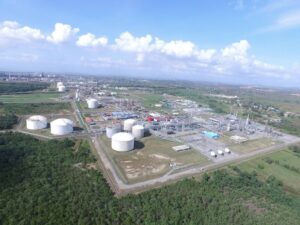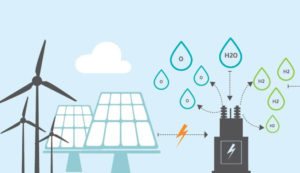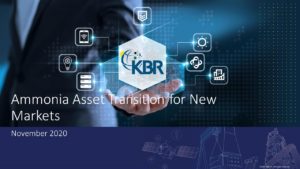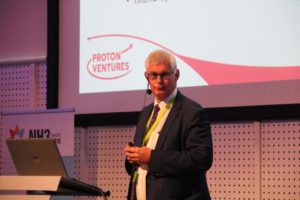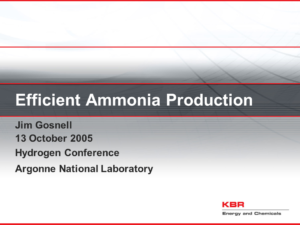Discussions will commence for the supply, purchase, and sale of ammonia from two of CIP’s ongoing mega-projects - St. Charles in Louisiana and Murchison in Western Australia - to Lotte in South Korea. Meanwhile, Lotte has selected KBR’s synthesis technology for its hydro-ammonia production project in Malaysia.
Content Related to KBR
Copenhagen Infrastructure Partners, Lotte plan offtake from mega-projects
Decarbonizing existing, SMR-based ammonia plants: workshop recap
Decarbonization of existing steam methane reforming-based ammonia plants is possible, and changes in gas and heat flows can be recovered via alternative technologies. Recap our workshop in Atlanta, where we discussed the use of upstream methane monitoring equipment, electrolysers, carbon capture, hydrogen burners, energy storage and electric heating to achieve decarbonization of conventional ammonia plants.
Harmonised certification – opportunities and challenges across different markets
In this session at our 2023 annual conference, panelists explored the challenges and opportunities for designing certification schemes for different markets. Moderated by Madhav Acharya, the discussion featured Emily Wolf from Ambient Fuel, Claire Behar from Hy Stor Energy, Domagoj Baresic from the UCL Energy Institute and Patrick Hastwell from KBR.
Compliance with EU standards offers flexibility for producers and will facilitate the immediate scale-up of export markets, but progress towards an umbrella-style certification scheme remains in focus for the AEA. Broad-based certification schemes will help create new voluntary demand markets and avoid a sector-by-sector approach to developing certification.
KBR, SolydEra to deploy solid oxide electrolysis for ammonia production
KBR will integrate SolydEra’s solid oxide electrolysis technology into its proprietary K-GreeN® ammonia synthesis process thanks to a new MoU. K-GreeN® is the technology of choice for several significant ammonia mega-projects, including Avina Clean Hydrogen (Texas), and ACME Group (Oman).
KBR to provide cracking tech for new South Korean project
KBR will deploy its new H2ACTSM ammonia cracking technology in Daesan, South Korea, delivering 200 tonnes of hydrogen per day as fuel for power generation. The new project is part of Hanwha Corporation’s decarbonisation push which includes co- and 100% firing of hydrogen fuel in gas turbines, ammonia production & export, and ammonia-powered vessels.
Flexible ammonia synthesis: shifting the narrative around hydrogen storage
Flexible ammonia production technology is currently scaling up to meet the challenges of fluctuating electricity feedstock. The ability to ramp down plants to 5 - 10% of their nominal load will minimize the requirement for hydrogen storage buffers and reduce the overall cost of renewable ammonia production. The first demonstration-sized flexible ammonia plants are due to begin operations later this year.
Electrolysis-based projects progress in USA & Canada
KBR has been selected as technology provider for two future production projects in Texas and Washington state. At the Port of Galveston, Texas Green Fuels has begun pre-FEED work and sourcing renewable electricity for its fuels export complex. And in Nova Scotia, Bear Head Energy has received environmental approval to proceed with its 2 million tonnes per year production project near Point Tupper.
Trinidad & Tobago launches roadmap to decarbonise hydrogen & ammonia production
Trinidad & Tobago’s National Energy Corporation, the Inter-American Development Bank and KBR have released their findings on how to establish a market for renewable hydrogen in the Caribbean country. Underpinned by a stepwise development of 57 GW of offshore wind power potential, the country could completely displace fossil-based hydrogen with renewable hydrogen in 2052. The 4 million tonnes-per-year production potential would meet industrial demands and lay the foundation for a significant export industry, potentially transforming Trinidad & Tobago into a global energy hub.
Production technology updates: from mega-scale to distributed ammonia
Recently, KBR launched its Ammonia 10,000 technology for newbuild ammonia plants, tripling the largest available single train capacity to 10,000 metric tonnes per day. In our latest Technology Insights article, we explore the other pieces of the puzzle required for mega-scale ammonia, as well as some updates from the other end of the spectrum, with three distributed, small-scale ammonia synthesis systems under development in North America.
KBR: ammonia-powered offshore drilling
KBR, Odfjell, Equinor and Wärtsilä will all collaborate to study conversion of diesel generators on board semi-submersible, offshore drilling vessels to ammonia-fueled generators. On-board power for equipment and heavy machinery on these vessels is typically provided by fossil-fed generators. As fuel costs increase, operators are looking to new energy solutions including offshore wind and alternative fuels like hydrogen & ammonia.
Nuclear-powered ammonia production
The potential for nuclear-powered ammonia production is developing fast. Two seperate industrial consortia (Copenhagen Atomics, Alfa Larval & Topsoe, and KBR & Terrestrial Energy) have formed to develop thorium-fueled reactors, and hydrogen & ammonia production is a key part of their plans. Given nuclear electricity dominates France’s energy mix, a grid-connected electrolyser project at Borealis’ fertiliser production plant in Ottmarsheim, France will be one of the first examples of commercial-scale, nuclear-powered ammonia production. And, while capital costs & lead times remain significant, mass production of new technologies and research into flexible power production capabilities are emerging as key to unlocking nuclear-powered ammonia production.
New ammonia partnerships in Japan, Indonesia
JGC Corporation has entered into a series of new ammonia partnerships. As part of a wider agreement to license KBR’s patented ammonia production technology, a new renewable ammonia pilot plant will be developed near Fukushima. JGC will team up in an “alliance agreement” with TOYO Corporation to develop fuel ammonia production projects and import terminals in Japan. And in Indonesia - where TOYO is currently assessing the feasibility of retrofitting an existing ammonia plant to run entirely on renewable energy - JGC and Indonesia’s national energy organisation Pertamina will collaborate on key decarbonisation projects.
Scatec joins ACME’s Oman green ammonia project
Scatec will enter into a 50:50 joint venture with ACME to design, develop, build, own and operate a planned large-scale, green ammonia facility in the Duqm Special Economic Zone of Oman. At full capacity the facility will produce 1.2 million tonnes of green ammonia per year, and the partners aspire to be “one of the first” commercial green ammonia facilities operating in the world. Advanced discussions for long-term off-take are already in progress. The project was launched last March by ACME and Oman government authority Tatweer, and added KBR as technology partner last October.
Green ammonia in Trinidad & Tobago
KBR has been awarded a study to help establish a green hydrogen economy in the dual-island nation. Repurposing of Trinidad & Tobago's existing industrial infrastructure - particularly grey hydrogen & ammonia production facilities - will be a key focus. Trinidad & Tobago occupies a crucial role in the global ammonia supply chain, but its reliance on grey hydrogen means that declining gas reserves and spiraling gas import prices have created shortfalls, with some ammonia production suspended and plants closed. A green ammonia project led by NewGen Energy will develop a 130 MW, solar-powered electrolyser facility in Point Lisas, and feed the state-owned Tringen I & II ammonia production plants 27,200 tonnes per year of green hydrogen feedstock.
KBR selected as technology partner for Oman green ammonia project
ACME has selected KBR to provide ammonia synthesis technology for its new green hydrogen & ammonia production facility to be built in Duqm, Oman. The project was first announced in March 2021, and has now grown to $3.5 billion in investment size, with energy to be provided by 3 GW of solar panels and 0.5 GW onshore wind power. The 2,400 tonnes per day (or 0.9 million tonnes per year) renewable ammonia facility is planned to be operational in 2022.
The Ammonia Wrap: ICE announces its new green ammonia "SuperGiant", Cummins and KBR team up on integrated solutions, a new green ammonia pilot in Minnesota and decarbonisation of existing plants in Russia
Welcome to the Ammonia Wrap: a summary of all the latest announcements, news items and publications about ammonia energy. There's so much news this edition that we're bringing you two, special Wrap articles. Our first focuses on ammonia production - both existing and new build plants. This week: InterContinental Energy to build 25 GW of green ammonia production in Oman, Cummins and KBR to collaborate on integrated green ammonia solutions, New green ammonia pilot plant for Minnesota, Stamicarbon launches new technology for sustainable fertilizer production in Kenya, Haldor Topsoe and Shchekinoazot to explore ammonia plant decarbonisation in Russia, 1 million tonne blue ammonia per year in Norway and Trammo announces off-take MoU for 2GW AustriaEnergy plant in Chile.
Ammonia infrastructure: panel wrap-up from the 2020 Ammonia Energy Conference
Infrastructure is key to realising the full potential of ammonia energy, enabling new markets and expanding the existing ones. By 2050 the hydrogen (and by extension, ammonia) market could be 20 times larger than it is today. What future possibilities are there to expand global ammonia production (currently 180 million tonnes per year) or trade volumes across the world’s oceans (currently 18 million tonnes per year)? On November 18, 2020, the Ammonia Energy Association (AEA) hosted a panel discussion moderated by Daniel Morris from KBR, as well as panel members Anthony Teo from DNV GL, Oliver Hatfield from Argus Media, and Michael Goff from Black & Veatch as part of the recent Ammonia Energy Conference. The panel’s insights from a number of different perspectives - market analytics, ship building and operating, as well as pipeline engineering - demonstrated ammonia's potential to become a low- or zero-carbon fuel of choice for the future. Current infrastructure can be adapted, new infrastructure can be built and operated cheaply, and lessons from previous fuel transitions can be taken on board to make the uptake of ammonia energy as smooth as possible.
Ammonia Asset Transition for New Markets
All together now: every major ammonia technology licensor is working on renewable ammonia
The second annual Power to Ammonia conference, which took place earlier this month in Rotterdam, was a tremendous success. It was again hosted by Proton Ventures, the Dutch engineering firm and mini-ammonia-plant pioneer, and had roughly twice as many attendees as last year with the same extremely high quality of presentations (it is always an honor for me to speak alongside the technical wizards and economic innovators who represent the world of ammonia energy). However, for me, the most exciting part of this year's event was the fact that, for the first time at an ammonia energy conference, all four of the major ammonia technology licensors were represented. With Casale, Haldor Topsoe, ThyssenKrupp, and KBR all developing designs for integration of their ammonia synthesis technologies with renewable powered electrolyzers, green ammonia is now clearly established as a commercial prospect.
